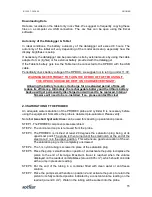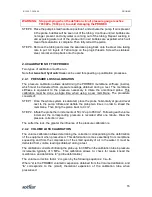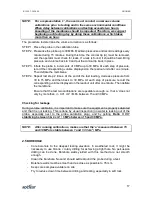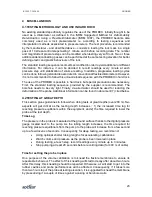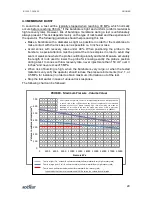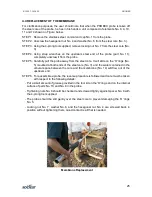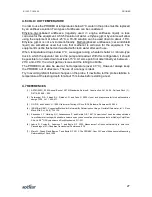
18
E10037-180424
PROBEX
2.6
SETTING THE PROBE IN PLACE
STEP 1. Unroll sufficient length of tubing and electrical cable, keeping in mind that normally
tests are carried on from the deepest test elevation upward. Protect their free ends
with dust caps.
Also, put some electrical tape on their free ends and apply
some Molykote grease on them.
Thread the tubing & cable through enough
casing lengths to reach testing depth. Be sure that the male thread of each length
is at the lower end of the string of casings.
Lengths of 1.5-m are recommended.
Connect cable and tubing to the probe. The electrical cable is normally longer than
the tubing. In order to reduce slack, twist the cable around the tubing and apply
some electrical tape and Molykote grease on this bundle. Leave enough slack to
allow insertion of the probe in the hole.
WARNING : CONNECTIONS BETWEEN THE PROBE AND THE TUBING & CABLE
MUST BE PROPERLY PROTECTED BY APPLYING ELECTRICAL TAPE AND
MOLYKOTE GREASE AS SHOWN BELOW.
STEP 2. Make hydraulic and electrical connections to the manual pump and readout unit
and check that the whole system is working well by inflating and deflating the
probe. Check the battery charge.
STEP 5. Insert the PROBEX into the borehole. To avoid the risk of damaging or losing the
probe in unstable boreholes, the electrical cable and tubing are normally threaded
in a NQ rods (or BW casing) before inserting the probe in the borehole. The probe
has a female BW casing thread at its upper end + an NQ rod adapter. Measure the
distance between the centre of the inflatable membrane and the upper end of the
PROBEX (including any adaptor) for exact determination of the elevation of the
probe in the borehole.
If possible, support the probe and casing string using a
slotted adaptor provided by Roctest. The use of a pull plate is dangerous and not
recommended.
Additionally, a casing clamp or a pipe vise should be used.
STEP 6. Position the deflated probe at the testing location, based on core examination. The
membrane must not straddle large cracks or rock types of significantly different
mechanical properties.
NEVER SUPPORT THE INSTRUMENT BY ITS TUBING OR CABLE
.
BE CAREFUL NOT TO DROP THE PROBE !
BE CAREFULL NOT TO TWIST PROBEX TUBING AND CABLE !












